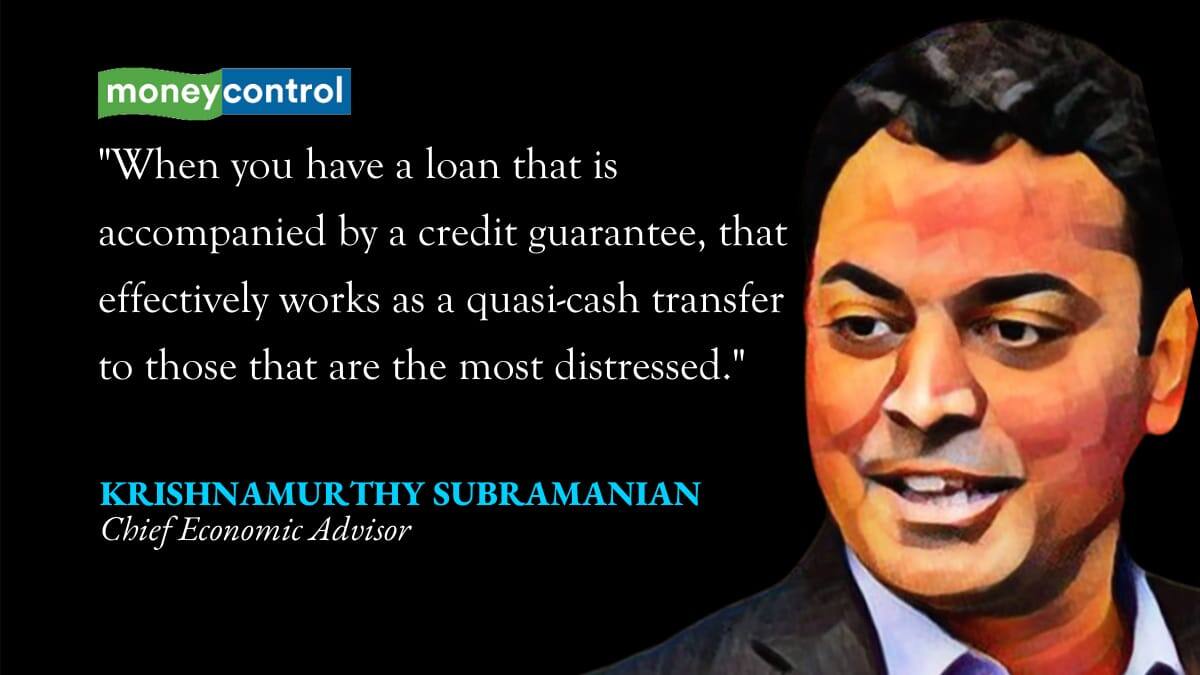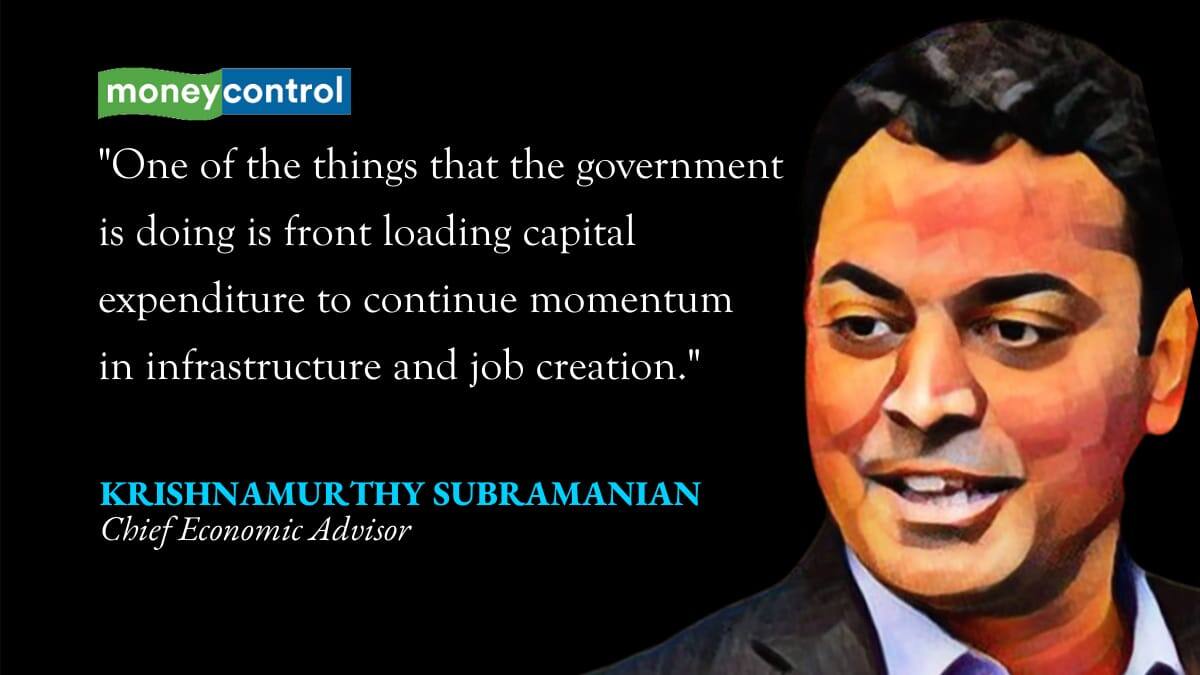Chief Economic Adviser Krishnamurthy V Subramanian
Chief Economic Advisor Krishnamurthy Subramanian says the economic impact of the third wave is expected to be much softer than that of the lockdown last year, and the second COVID wave. This is because vaccination numbers are rising and the states and the Centre have learnt to contain lockdowns better.
“So, in itself, the health impact of the third wave may be much less than the second wave. The second wave’s economic impact was much lower than the first wave. When you take all of them into account, I think the third wave’s economic impact may not be very large,” Subramanian said in an interview with Moneycontrol.
Subramanian also said that the credit guarantee schemes to small individual borrowers as well as various sectors can be treated as quasi-income support, while effectively ruling out fiscal measures, apart from the ones announced in the budget, which, he said, will have a much larger multiplier effect on economic activity, consumption and job creation.
Excerpts:
India recently agreed to the G-20/OECD Base Erosion Profit Shifting Framework. Is there an understanding that once negotiations are settled by October, and India adopts the framework, it will let go of the equalisation levy?
Before we get into the details, what is really important to understand is the overall ramifications for India. Firstly, after the corporate tax rate cuts in 2019, we are basically at 15 percent, if you don't have any exemptions, yeah. This is an instance of India actually implementing it much earlier than the G 20 nations.
The second, because of the huge consumer base that we have, the attempt is to have this minimum tax and discourage companies from choosing tax havens. That's something which will actually be beneficial for India, especially when it comes to the digital economy. A large proportion of consumers of the digital economy are going to be in India. So, I think the BEPS framework will be overall beneficial.
As far as the specifics of the equalisation levy are concerned, I think that is something which is too early to get into at this stage. In spirit, what is being talked about here is to ensure that the sovereign, where the digital economy activities are happening, gets the benefit of taxing those activities. From India's perspective, that is something which is beneficial.
The finance minister recently announced a relief package with credit-side measures for tourism and the small individual borrowers under the micro-finance institutions (MFIs). Is that enough as opposed to fiscal income support?
When you have a loan that is accompanied by a credit guarantee, that effectively works as a quasi-cash transfer to the most distressed. We have to understand how this reaches out to the most needy.
There are three categories of borrowers, generally. First, people like you and me, who are not as impacted. Even if a loan is given with a credit guarantee, we may not take it. The second category are those who are actually in temporary distress. So they will want to borrow now, but will be able to repay that. The third category is those that are distressed now, and will also be distressed when the loan comes up for repayment. Now, absent a guarantee, financial institutions would not want to lend to the second and the third category. So when you give the guarantee, that risk is taken by the government.
Especially for the third category of borrowers, what then happens is that they have gotten this cash today, but they may not be able to repay, and the cost of that is being borne by the government. As you can see here, this works out to be a well-directed transfer to those that are genuinely distressed. Let's say, of the 40 crore Jan Dhan accounts, you want to lend through the MFI scheme to 20 crore. In a direct cash transfer, the fiscal cost will be too high, but with a scheme like this you can intervene. And that is why even the emergency credit loan guarantee scheme (ECLGS) has been so successful. The only difference between the ECLGS and MFI lending scheme is that the target category is different.
There is another important factor here. When you look at the fourth quarter numbers, the gross fixed capital formation was at a 26-quarter high. This means that the construction sector grew and created jobs in the informal sector, which also showed up in consumption increasing after having declined for three quarters. This is important because one of the other things that the government is doing is front-loading capital expenditure to continue that momentum in infrastructure and job creation.
So that, combined with the loan guarantee through MFIs is very important for the urban poor. So you have these steps, plus the ECLGS. Our stance is that if the schemes work well, they will be continued and expanded..

How concerned is the government about the third wave and its economic impact?
On the third wave, there are a couple of things that we must keep in mind. There should be some fear, so that people take the necessary precautions. If you look at the data, close to 37 crore people have got at least the first shot of vaccine. Even that provides some sort of immunity.
If you look at the serological evidence and pace of vaccinations, I think the third wave may not be as devastating as last year and the second wave, economically speaking. We have learned how to impose localised restrictions better at the states. By not clamping down on essential activities and not stopping interstate trade, the central and state governments have ensured that the second wave’s economic impact has been much lower than the lockdown.
So, in itself, the health impact of the third wave may be much less than the second wave. And the second wave’s economic impact was much lower than the first wave’s. When you take all that into account, I think the third wave’s economic impact may not be very large.
Are you completely ruling out direct income support or job support schemes? Are the budget announcements on public investment your main plank of recovery?
Such measures will be revenue expenditure. When you spend fiscally, the revenue expenditure multipliers are not large, and if revenue expenditure is not well directed, you don’t get much bang for the buck, as we saw in the responses after the 2008 global financial crisis.
That’s why it is really critical that whatever programmes we are coming up with, the interventions are well-targeted, so that the taxpayers money is actually spent responsibly. I don't think it’s right to actually just succumb to the pressure and do what is not right for the economy.
In revenue expenditure, if you spend Rs 100, the economy adds only 90-98. As opposed to capital expenditure, if you spend 100 bucks, you get a multiplier of 450 bucks..

On the receipt side, while GST and income tax collections have been encouraging, we still have not seen major divestment plans taking place. The LIC IPO and the privatisation of Air India, Bharat Petroleum and others are still pending.
Work is going on. We are readying LIC for the planned initial public offering, the books are being cleaned up. The government is doing the work to ensure that this year's divestment target of Rs 1.75 lakh crore is met. I am quite confident that we will meet the target. These plans of PSU privatisation are being periodically monitored. Do also remember that these plans are a spillover from last year, so a lot of work has already been done. You will see some of these plans fructifying soon.
How confident is the government of fully vaccinating 94 crore adults by the end of the year?
The supply of vaccines is what needs to be really focused on. From what I understand, both August and September will see a major ramp-up in supply.